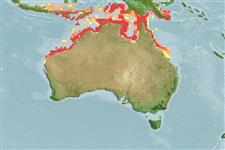Teleostei (teleosts) >
Eupercaria/misc (Various families in series Eupercaria) >
Labridae (Wrasses) > Bodianinae
Etymology: Choerodon: Greek, choiros = a pig + odous = teeth (Ref. 45335); referrring to the prominent anterior canines of the species in this genus (Ref. 116605).
More on author: Ogilby.
Environment: milieu / climate zone / depth range / distribution range
Ecology
Marine; demersal; depth range 10 - 40 m (Ref. 90102). Tropical
Western Pacific: Aru Is. (Indonesia), Papua New Guinea and northern Australia.
Size / Weight / Age
Maturity: Lm ? range ? - ? cm
Max length : 20.0 cm TL male/unsexed; (Ref. 3132)
Dorsal spines (total): 13; Dorsal soft rays (total): 7; Anal spines: 3; Anal soft rays: 10. Body with a prominent dusky stripe on lateral midline; a prominent dusky spot present midlaterally at posterior end of caudal peduncle; no dark spot on dorsal fin in adults. Second prominent anterior canine distinctly curved posterolaterally. Body of moderate depth at level of dorsal- fin origin (2.7 to 2.9 times in SL).
Inhabits flat sandy or weedy areas.
Life cycle and mating behavior
Maturity | Reproduction | Spawning | Eggs | Fecundity | Larvae
Oviparous, distinct pairing during breeding (Ref. 205).
Allen, G.R. and R. Swainston, 1988. The marine fishes of north-western Australia: a field guide for anglers and divers. Western Australian Museum, Perth. 201 p. (Ref. 3132)
IUCN Red List Status (Ref. 130435: Version 2024-1)
Threat to humans
Harmless
Human uses
Tools
Special reports
Download XML
Internet sources
Estimates based on models
Preferred temperature (Ref.
123201): 24.8 - 28.8, mean 27.7 °C (based on 204 cells).
Phylogenetic diversity index (Ref.
82804): PD
50 = 0.5000 [Uniqueness, from 0.5 = low to 2.0 = high].
Bayesian length-weight: a=0.01288 (0.00577 - 0.02877), b=3.05 (2.85 - 3.25), in cm total length, based on LWR estimates for this (Sub)family-body shape (Ref.
93245).
Trophic level (Ref.
69278): 3.4 ±0.4 se; based on size and trophs of closest relatives
Resilience (Ref.
120179): Medium, minimum population doubling time 1.4 - 4.4 years (Preliminary K or Fecundity.).
Fishing Vulnerability (Ref.
59153): Low vulnerability (10 of 100).
Nutrients (Ref.
124155): Calcium = 202 [103, 402] mg/100g; Iron = 1.22 [0.65, 2.45] mg/100g; Protein = 18.1 [15.3, 20.1] %; Omega3 = 0.275 [0.156, 0.489] g/100g; Selenium = 37.7 [19.2, 78.4] μg/100g; VitaminA = 41.1 [11.1, 162.7] μg/100g; Zinc = 1.32 [0.91, 2.17] mg/100g (wet weight);
